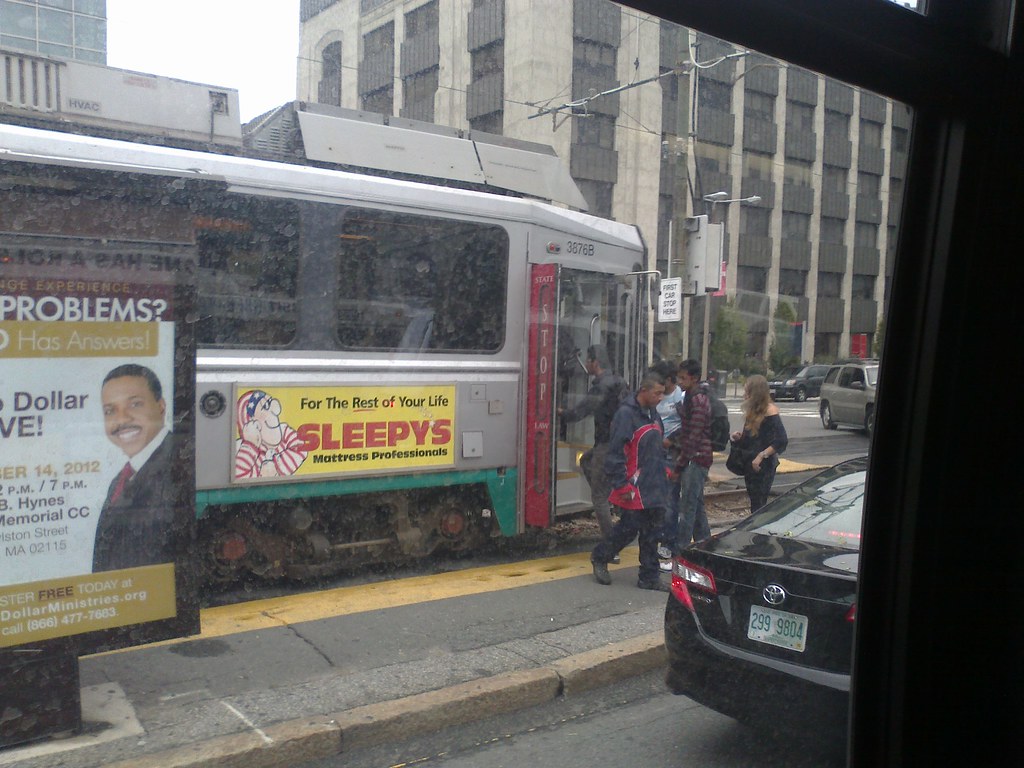 |
| New MBTA map design from Mikheil Kvrivishvili (see also: larger PDF from UHub) |
The design is clearly a conservative approach, duplicating many style elements of the existing map. However, I think that there were some places where the MBTA really should have looked for some significant change:
The map doesn't really do frequency mapping and even takes a step backwards. Frequency mapping means that the width of the line on the map has some relationship to the frequency of vehicle arrival on the ground. Several designs were submitted that showed the Green Line frequency being cut to one-fourth on the surface branches, compared to the subway. Anyone who has ridden the Green Line "B" branch knows that it is unfair to categorize it in the same class as the Red Line through Cambridge. Yet, that is what the current and new maps do.
The T actually asked designers to make the key bus route lines smaller, and now the commuter rail lines are bigger! For example, this is confusing to a person trying to get from Hyde Park to Back Bay at an arbitrary time of day. The commuter rail looks like the more important element of the map, but it only stops there twenty-one times a day, with a huge gap at peak hours. The 32 bus is generally the more usable option.
The map is worse than the current one at depicting geographic relationships. Yes, of course, it's not supposed to show accurate geography. But introducing cleverly chosen hybrid elements of geography can help users make smarter decisions about selecting one line or the other, or perform out-of-system transfers. A big loss that stands out to me is the disconnection of Cleveland Circle and Reservoir. These are essentially the same station, with track connection via the Reservoir carhouse. Travelers going between branches of the Green Line can exploit the proximity of the "C" and "D" (and also nearby "B") at Cleveland Circle to save time and avoid transferring at Kenmore. Instead, this new map depicts the three branches as being further apart than Heath Street and Forest Hills -- stations which are not at all close to each other. Another one is Copley/Back Bay, which is a major Green/Orange/commuter rail out-of-system transfer, but is not even hinted at by this new map, despite being in a heavily touristed area. Well, at least the depiction of the 39 bus route is fixed.
In other places, geography is inexplicably included: the Needham line being a prime example. Why is it relevant to show that the Needham line curves northward? That could have easily been a short strip of station names. Why is there a dip in the Newburyport line near Chelsea? That's a useless geographic element. Why does the Blue Line take a sharp 90-degree turn -- making it ugly and exceptional -- while the Green Line does a soft turn between Haymarket and North Station? Why is the Silver Line airport loop reduced to a tiny note, while the nearly irrelevant downtown meanderings of the Silver Line occupy a huge portion of the map?
It appears that a significant compromise was made in order to include all of the Green Line "station" names. This is a really puzzling goal. Many of these "stations" are just strips of asphalt, or a post in the street, located two blocks away from each other. The names of the Silver Line stations are smaller, but not really any less significant. I don't think it was worthwhile to give up all geographic cues about the Green Line in exchange for full, large-font station names that are nearly the same font-size as the major underground stations. Shouldn't we be working on eliminating some of these ridiculously bunched stations, anyway?
 |
| Is Chestnut Hill Avenue "station" nearly as important as Kenmore? |
 |
| St Paul Street "station" is only slightly better. Is this really comparable to Copley? |
The MassPort shuttle buses at the airport continue to be de-emphasized, which is unfortunate. They are actually quite decent, especially with the new low floor buses, and new real-time countdown boards, which are also integrated with the Silver Line. I personally prefer using the Blue Line to Logan, but it seems that the MBTA is trying to push all the tourists towards the Silver Line (not to mention the free fares!). Actually, on second thought, I'm okay with this.
The new map design is an improvement on the old map and a significant clean-up. I think the major flaws are: missing the chance to do frequency mapping, emphasizing commuter rail over key bus routes, compromising geographic elements for Green Line "station" names, failing to hint at sensible out-of-system transfers, and turning the Silver Line airport loop into a line, somehow.
No comments:
Post a Comment
Note: Only a member of this blog may post a comment.